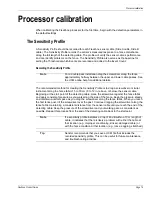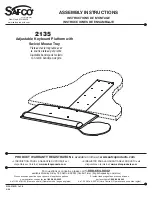
Page 68
FlexZone Product Guide
FlexZone setup and calibration requires:
1. Setting the initial configuration parameters as required (Cable Supervision, Network Address,
Network configuration, processor Synchronization, single or double cable pass).
2. Setting up the power distribution and alarm data communication schemes.
3. Conducting a Sensitivity Profile for each sensor cable (A-Side, B-side).
4. Adjusting the cables’ threshold settings and detection parameters (Event Window, Event
Count, Alarm Window).
5. Defining and setting up the cable segments and alarm zone boundaries.
6. Setting up the Auxiliary input/output control.
7. Testing the installation.
FlexZone definitions
•
meter
- The meter is the basic unit of measure for FlexZone sensor cable. The meter is used
to define cable segments. The sensitivity profile records the cable sensitivity for each meter of
detecting sensor cable.
•
cable segment
- A cable segment is made up of a contiguous group of meters, and is used for
display and control purposes. Cable segments are software-defined during setup. The cable
segment is the smallest unit that is defined by the end-user. Each sensor cable can be divided
into up to 50 cable segments. Cable segments are used to create alarm zones, and therefore,
must begin and end where alarm zone boundaries are required. A single cable segment, or
multiple cable segments, can be assigned to one zone. A cable segment can have one of the
four onboard relays associated with it for alarm reporting. In addition to the event Threshold
that is set for the full length of detecting cable, an independent Threshold adjustment can be
made for each cable segment. Cable segments can also be defined as inactive, whereby
detecting cable will not report valid targets (by assigning a cable segment to Zone 0).
•
alarm zone
- An alarm zone is made up of one or more cable segments, and is used for the
control and annunciation of sensor alarms (access/secure, graphic map display with precise
target location). There can be up to 60 alarm zones per FlexZone-60 processor (over two
sensor cables) and up to four for a FlexZone-4 processor. Alarm zones are defined in software
to match the site-specific zone layout details (e.g., CCTV coverage, fence sections, gates,
buildings, etc.). Any grouping of segments can be assigned to an alarm zone. The cable
segments do not have to be contiguous, and can come from both sensor cables on one
processor (not two processors). There can be a zone within another zone, and a zone can
bridge inactive cable segments. Zone 0 does not report alarms, and is used for cable
bypasses, and to set detecting cable to inactive (non-detecting). Zone 0 does not count in the
60, or 4 zone total.
Understanding FlexZone alarm detection
The FlexZone processor constantly evaluates the input signals from the sensor cables to
discriminate between intrusion events and environmental activity. The characteristic response of a
cut event is a sharp spike with a fast rising and fast falling edge. For a climb event, the response
includes the fast rising edge caused by the initial contact with the fence, which is followed by a
series of peaks and valleys resulting from the continued presence and changing stresses on the
fence. Environmental activity is generally of longer duration, lower magnitude, and has more
gradual increases and decreases. The FlexZone processor analyzes the received signals from the
sensor cables and records separate Events independently. As a result, the processor can record
and report multiple disturbances over the length of the sensor cable.
Note
FlexZone’s minimum target resolution for perfectly synchronized
disturbances is 24 m (79 ft.).
















































